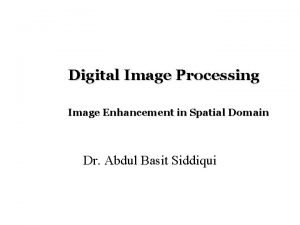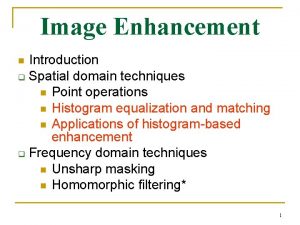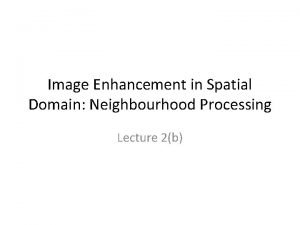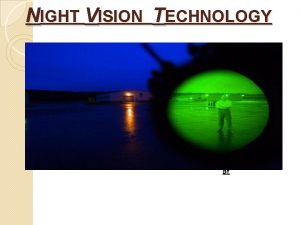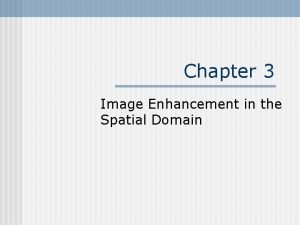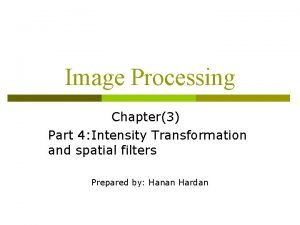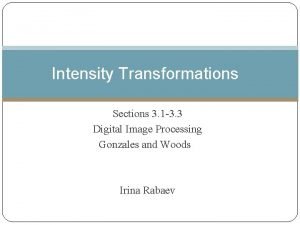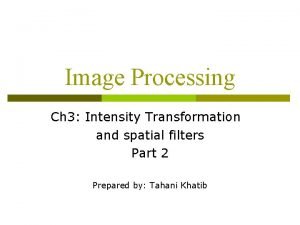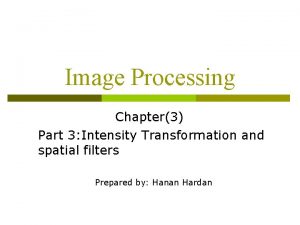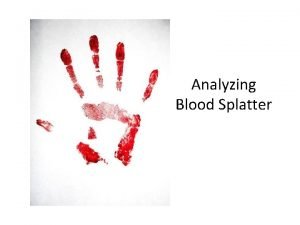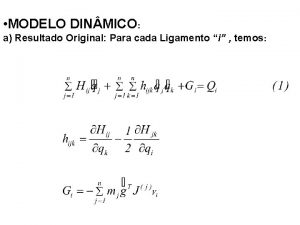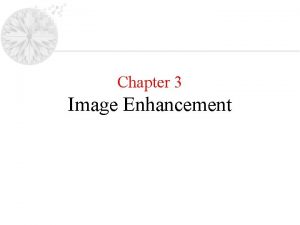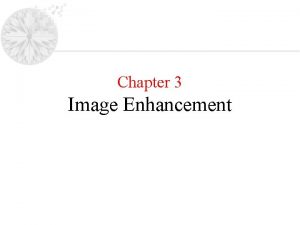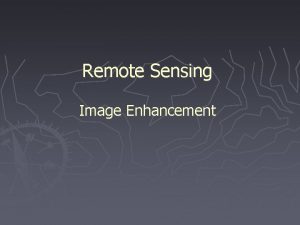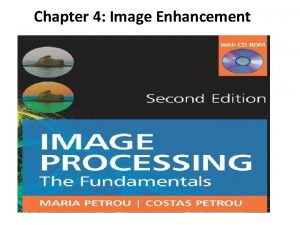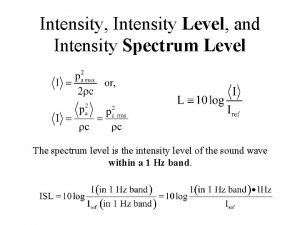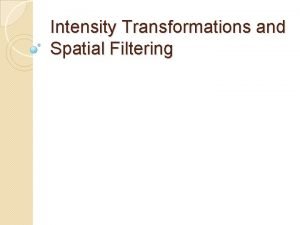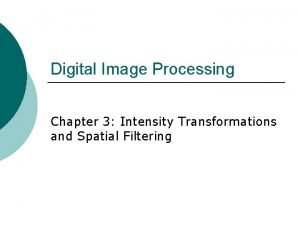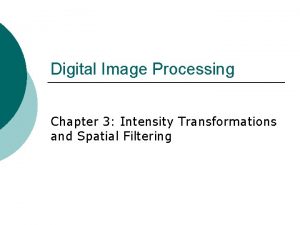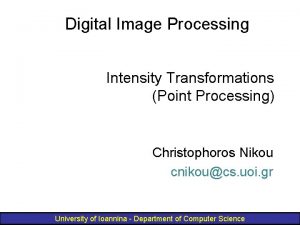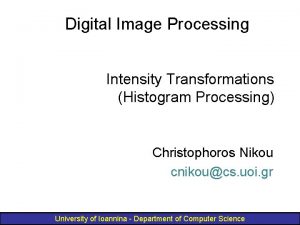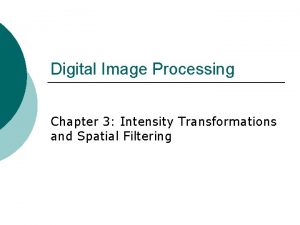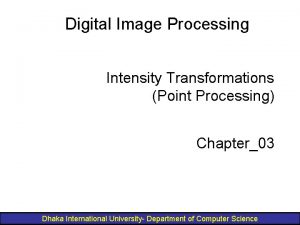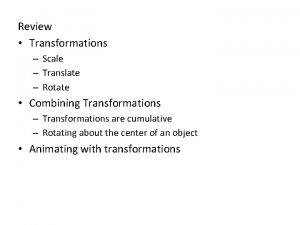Intensity Transformations Image Enhancement Intensity Transformations Enhancement of




![Image Negatives: T[g] = G - 1 - g G-1 0 transformed pixel value Image Negatives: T[g] = G - 1 - g G-1 0 transformed pixel value](https://slidetodoc.com/presentation_image/2729914047ee47fe21ec9aaa9e98e83e/image-5.jpg)
![Image Negatives: T[g] = G - 1 - g Image Negatives: T[g] = G - 1 - g](https://slidetodoc.com/presentation_image/2729914047ee47fe21ec9aaa9e98e83e/image-6.jpg)

![Thresholding T[g] = 0, g < TH G - 1, TH < g G-1 Thresholding T[g] = 0, g < TH G - 1, TH < g G-1](https://slidetodoc.com/presentation_image/2729914047ee47fe21ec9aaa9e98e83e/image-8.jpg)
![Thresholding T[g] = 0, g < TH G - 1, TH < g Thresholding T[g] = 0, g < TH G - 1, TH < g](https://slidetodoc.com/presentation_image/2729914047ee47fe21ec9aaa9e98e83e/image-9.jpg)

![Square Root Transformation T[g] = g * G-1 transformed pixel value TRANSFORMATION FUNCTION original Square Root Transformation T[g] = g * G-1 transformed pixel value TRANSFORMATION FUNCTION original](https://slidetodoc.com/presentation_image/2729914047ee47fe21ec9aaa9e98e83e/image-11.jpg)
![Square Root Transformation T[g] = g * G-1 Square Root Transformation T[g] = g * G-1](https://slidetodoc.com/presentation_image/2729914047ee47fe21ec9aaa9e98e83e/image-12.jpg)

![Contrast Stretching (to the minimum and maximum values in the image) 0, T[g] = Contrast Stretching (to the minimum and maximum values in the image) 0, T[g] =](https://slidetodoc.com/presentation_image/2729914047ee47fe21ec9aaa9e98e83e/image-14.jpg)

![Contrast Stretching T[g] = 0, 0 < g < LO (G - 1) (g Contrast Stretching T[g] = 0, 0 < g < LO (G - 1) (g](https://slidetodoc.com/presentation_image/2729914047ee47fe21ec9aaa9e98e83e/image-16.jpg)

![Histogram Equalization T[g] = G P[g] - 1 Histogram Equalization T[g] = G P[g] - 1](https://slidetodoc.com/presentation_image/2729914047ee47fe21ec9aaa9e98e83e/image-18.jpg)
![Histogram Equalization T[g] = G P[g] - 1 g= 0 1 2 3 4 Histogram Equalization T[g] = G P[g] - 1 g= 0 1 2 3 4](https://slidetodoc.com/presentation_image/2729914047ee47fe21ec9aaa9e98e83e/image-19.jpg)
![Histogram Equalization T[g] = G P[g] - 1 g= 0 1 2 3 4 Histogram Equalization T[g] = G P[g] - 1 g= 0 1 2 3 4](https://slidetodoc.com/presentation_image/2729914047ee47fe21ec9aaa9e98e83e/image-20.jpg)



![- using our transformation T[. ], average intensity and contrast are increased - grey - using our transformation T[. ], average intensity and contrast are increased - grey](https://slidetodoc.com/presentation_image/2729914047ee47fe21ec9aaa9e98e83e/image-24.jpg)

- Slides: 25

Intensity Transformations

Image Enhancement: Intensity Transformations Enhancement of the image is achieved by transforming its pixel values. new[i, j] = T [ original[i, j] ] where T[. ] is the intensity transformation One effect of applying the intensity transformation is that the intensity distribution of the image will also be changed.

Identity Transformation transformed pixel value 0 G-1 TRANSFORMATION FUNCTION 0 G-1 original pixel value

Image Negatives: Digital negatives are often produced if the region of interest contains mostly darker pixels (low intensity values)
![Image Negatives Tg G 1 g G1 0 transformed pixel value Image Negatives: T[g] = G - 1 - g G-1 0 transformed pixel value](https://slidetodoc.com/presentation_image/2729914047ee47fe21ec9aaa9e98e83e/image-5.jpg)
Image Negatives: T[g] = G - 1 - g G-1 0 transformed pixel value TRANSFORMATION FUNCTION 0 G-1 original pixel value
![Image Negatives Tg G 1 g Image Negatives: T[g] = G - 1 - g](https://slidetodoc.com/presentation_image/2729914047ee47fe21ec9aaa9e98e83e/image-6.jpg)
Image Negatives: T[g] = G - 1 - g

Thresholding: Thresholding is often used to segment an image into figure/background
![Thresholding Tg 0 g TH G 1 TH g G1 Thresholding T[g] = 0, g < TH G - 1, TH < g G-1](https://slidetodoc.com/presentation_image/2729914047ee47fe21ec9aaa9e98e83e/image-8.jpg)
Thresholding T[g] = 0, g < TH G - 1, TH < g G-1 0 transformed pixel value TRANSFORMATION FUNCTION 0 original pixel value G-1
![Thresholding Tg 0 g TH G 1 TH g Thresholding T[g] = 0, g < TH G - 1, TH < g](https://slidetodoc.com/presentation_image/2729914047ee47fe21ec9aaa9e98e83e/image-9.jpg)
Thresholding T[g] = 0, g < TH G - 1, TH < g

Square Root Transformation: The square root transformation is useful for brightening the darkest regions in an image.
![Square Root Transformation Tg g G1 transformed pixel value TRANSFORMATION FUNCTION original Square Root Transformation T[g] = g * G-1 transformed pixel value TRANSFORMATION FUNCTION original](https://slidetodoc.com/presentation_image/2729914047ee47fe21ec9aaa9e98e83e/image-11.jpg)
Square Root Transformation T[g] = g * G-1 transformed pixel value TRANSFORMATION FUNCTION original pixel value
![Square Root Transformation Tg g G1 Square Root Transformation T[g] = g * G-1](https://slidetodoc.com/presentation_image/2729914047ee47fe21ec9aaa9e98e83e/image-12.jpg)
Square Root Transformation T[g] = g * G-1

Contrast Stretching: Contrast stretching is used to increase the dynamic range of values within an image
![Contrast Stretching to the minimum and maximum values in the image 0 Tg Contrast Stretching (to the minimum and maximum values in the image) 0, T[g] =](https://slidetodoc.com/presentation_image/2729914047ee47fe21ec9aaa9e98e83e/image-14.jpg)
Contrast Stretching (to the minimum and maximum values in the image) 0, T[g] = 0 < g < LO (G - 1) (g - LO), LO < g < HI (HI - LO) G - 1, HI < g < G -1

Contrast Stretching 0 < g < LO (G - 1) (g - LO), (HI - LO) LO < g < HI G - 1, HI < g < G-1 TRANSFORMATION FUNCTION transformed pixel value T[g] = 0, LO HI original pixel value
![Contrast Stretching Tg 0 0 g LO G 1 g Contrast Stretching T[g] = 0, 0 < g < LO (G - 1) (g](https://slidetodoc.com/presentation_image/2729914047ee47fe21ec9aaa9e98e83e/image-16.jpg)
Contrast Stretching T[g] = 0, 0 < g < LO (G - 1) (g - LO), (HI - LO) LO < g < HI G - 1, HI < g < G-1

Histogram Equalization : Histogram equalization attempts to obtain an even distribution of intensity values in the image, often resulting in increased contrast.
![Histogram Equalization Tg G Pg 1 Histogram Equalization T[g] = G P[g] - 1](https://slidetodoc.com/presentation_image/2729914047ee47fe21ec9aaa9e98e83e/image-18.jpg)
Histogram Equalization T[g] = G P[g] - 1
![Histogram Equalization Tg G Pg 1 g 0 1 2 3 4 Histogram Equalization T[g] = G P[g] - 1 g= 0 1 2 3 4](https://slidetodoc.com/presentation_image/2729914047ee47fe21ec9aaa9e98e83e/image-19.jpg)
Histogram Equalization T[g] = G P[g] - 1 g= 0 1 2 3 4 5 6 7 p[g] =. 19 . 25 . 16 . 13 . 10 . 07 . 06 . 04 P[g] =. 19 . 44 . 60 . 73 . 83 . 90 . 96 1. 00 T[g] = 1 3 4 5 6 6 7 7
![Histogram Equalization Tg G Pg 1 g 0 1 2 3 4 Histogram Equalization T[g] = G P[g] - 1 g= 0 1 2 3 4](https://slidetodoc.com/presentation_image/2729914047ee47fe21ec9aaa9e98e83e/image-20.jpg)
Histogram Equalization T[g] = G P[g] - 1 g= 0 1 2 3 4 5 6 7 p[g] =. 19 . 25 . 16 . 13 . 10 . 07 . 06 . 04 P[g] =. 19 . 44 . 60 . 73 . 83 . 90 . 96 1. 00 3 4 5 6 6 7 7 T[g] = 1 ORIGINAL HISTOGRAM. 25. 20 CUMULATIVE HISTOGRAM 1. 0. 80 . 15 . 60 . 10 . 40 . 05 . 20 . 00

ORIGINAL HISTOGRAM UNIFORM HISTOGRAM . 25 . 20 . 15 . 10 . 05 . 00 0 1 2 3 4 5 6 7

ORIGINAL HISTOGRAM UNIFORM HISTOGRAM . 25 . 20 . 15 . 10 . 05 . 00 0 1 2 3 4 5 6 7 0 CUMULATIVE HISTOGRAM 1 2 3 4 5 6 CUMULATIVE HISTOGRAM 1. 0 . 80 . 60 . 40 . 20 . 00 7

Example: Consider an image with eight possible intensity values (a three bit image) g= 0 1 2 3 4 5 6 7 p[g] =. 19 . 25 . 16 . 13 . 10 . 07 . 06 . 04 T[g] = 1 3 4 5 6 6 7 7 ORIGINAL HISTOGRAM TRANSFORMED HISTOGRAM . 25 . 20 . 15 . 10 . 05 . 00 0 1 2 3 4 5 6 7
![using our transformation T average intensity and contrast are increased grey - using our transformation T[. ], average intensity and contrast are increased - grey](https://slidetodoc.com/presentation_image/2729914047ee47fe21ec9aaa9e98e83e/image-24.jpg)
- using our transformation T[. ], average intensity and contrast are increased - grey level order of the image is preserved, such that for any two grey levels g 1 and g 2 , and their corresponding transformed values T[g 1 ] and T[g 2 ], _ g if and only if T[ g ] <_ T[ g ] g 1< 2 1 2 * grey level order will only be preserved if the transformation is monotone increasing

Original image: Histogram equalized image:
 Image enhancement in spatial domain
Image enhancement in spatial domain Objective of image enhancement
Objective of image enhancement Logarithmic transformation in image processing
Logarithmic transformation in image processing Gonzalez
Gonzalez Gamma correction image processing
Gamma correction image processing Image enhancement in spatial domain
Image enhancement in spatial domain Fractal image
Fractal image Image enhancement in spatial domain
Image enhancement in spatial domain Image enhancement in night vision technology
Image enhancement in night vision technology Image enhancement in spatial domain
Image enhancement in spatial domain Intensity transformations and spatial filtering
Intensity transformations and spatial filtering Intensity transformation and spatial filtering
Intensity transformation and spatial filtering What are intensity transformations?
What are intensity transformations? Intensity transformations and spatial filtering
Intensity transformations and spatial filtering What are intensity transformations?
What are intensity transformations? Intensity transformations and spatial filtering
Intensity transformations and spatial filtering Power-law (gamma) transformations
Power-law (gamma) transformations Intensity transformation in digital image processing
Intensity transformation in digital image processing Intensity level slicing matlab
Intensity level slicing matlab Image geometry in digital image processing
Image geometry in digital image processing Image sharpening in digital image processing
Image sharpening in digital image processing Search for an image using an image
Search for an image using an image Virtual vs real image
Virtual vs real image Qual o resultado de: image image
Qual o resultado de: image image Image segmentation in digital image processing
Image segmentation in digital image processing Noise
Noise
